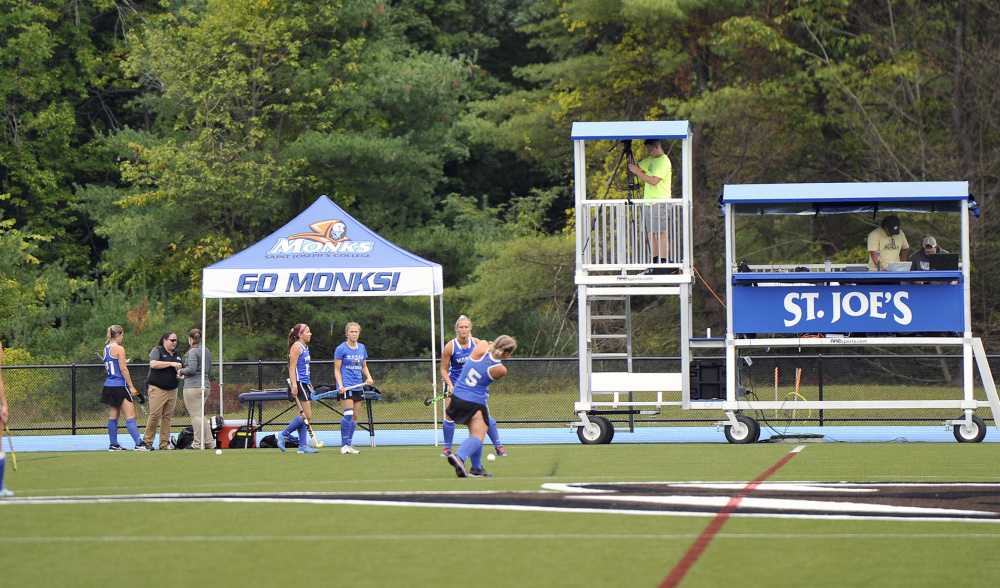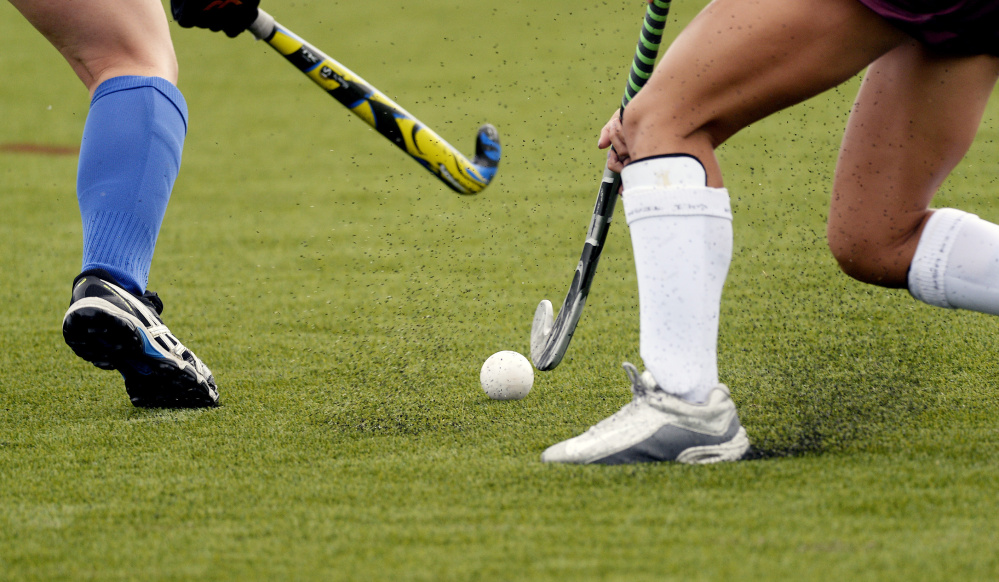STANDISH — What does having a new artifical turf field and eight-lane outdoor track do for the St. Joseph’s College athletic program?
“It means that where we are is where we should have been,” said Brian Curtin, the Monks’ athletic director. “It means a lot to the institution. We’ve already seen a spike in enrollment because of it, with (increased) roster sizes for men’s lacrosse and women’s and men’s track.”
The Monks opened their field this fall and have been putting it to good use. The already strong programs in men’s and women’s soccer, and field hockey are a combined 5-0-1 at the $5 million complex after Wednesday’s 2-1 field hockey victory against previously unbeaten Springfield College.
They have happily adapted to playing on the larger, smooth surface installed by Saco-based Northeast Turf instead of their smallish and overused grass fields.
“I think it just opens up a whole new opportunity for even more success,” said Haley DaGraca of Saco, a speedy junior forward who scored three goals Monday in a 5-0 victory against Southern Maine in women’s soccer. “Everyone is so ready to play on it and I think teams are going to do so much better because we have this motivating factor behind us.”
Another private college in Maine will unveil a new artificial field Saturday when the Bowdoin College football team meets Middlebury.
For Bowdoin, the new turf field, installation of lights, and replacing the old six-lane track with an eight-lane, championship caliber track cost $4.5 million. It was built on an existing and historic site at Whittier Field.
The field is still lined by old-growth pine trees. The brick and wrought-iron entrance gate erected in 1928 remains. Importantly, the stone foundation, and original footprint and access points to the covered Hubbard Grandstand, built in 1903, has been revealed by the removal of bleachers that were built around it over the years.
“We’re really excited about the way the facility comes together,” said Tim Ryan, the Bowdoin athletic director.
Bowdoin’s project will allow men’s lacrosse to use Whittier Field in the spring and provide football a weather-proof practice site, freeing existing space for other varsity and intramural athletic needs.
The two new fields are examples of athletic programs at all levels switching from natural grass to a synthetic surface to maximize playability, something especially important in late fall and early spring in Maine.
There are more than 8,000 synthetic, multiuse sports fields in use in North America at the high school, college and professional level, according to the Synthetic Turf Council.
Curtin said St. Joseph’s chose a crumb rubber infill for its field after doing extensive research.
In 2014, an NBC News report suggested a link between crumb rubber and cancer cases among soccer players. Since then, several studies have shown no evidence that type of infill, made from recycled tires, was carcinigous.
Both colleges used fundraising and private donors to pay for the improvements. Neither has assessed additional student fees.
Also, both are planning a second phase to add further improvements, pending town and, in Saint Joseph’s case, board, approval.
St. Joseph’s next project will be to add permanent seating, a press box and locker-room facilties.
Bowdoin already has built a needed, enclosed press box but is looking to spend another $3.5 million to construct a building for locker rooms, equipment and training.
A big component of St. Joseph’s project was the installation of the eight-lane track. The college of about 1,000 students began its varsity track program in 2012-13 and never has had its own track.
“It’s going to be a great selling point for us. I’ve been telling recruits about the new outdoor track and field complex, and they’re excited to visit,” said Scott Hutchinson, the cross country and track coach.
“Numbers have already doubled for cross country and for track they’ll triple. Last year we had maybe 10 to 12 athletes per gender for track. “
Hutchinson said his goal is to have 50 to 60 track athletes per gender and to consistently get athletes quaified for the NCAA regional.
In the short term, the track athletes are taking pride in having their own facility.
“We had our first track workout (Tuesday), and it was just a great morale booster and a lot of smiles,” said senior captain Lucas Fisher, a distance runner from Strafford, New Hampshire. “Everyone was having a great time just running on our own track.”
The lacrosse teams also will gain a new, permanent home, said Curtin, instead of playing and usually practicing at Deering High in Portland.
“We’ve hosted playoff games at Deering. We won a title there but it’s not a campus life experience there,” Curtin said. “This enhances our entire campus.”
“I think it also shows the athletes that the school is ready to support them, and this has been needed for awhile and now we have it,” said Jenelle Harris, the women’s soccer coach. “And it’s not just the athletes.The staff, students and faculty are more than welcome to go out and use it.”
Curtin said he’s already given officials from the Maine Principals’ Association a tour of the facility and hopes it’s used for high school events.
The school has been the site for high school baseball and softball tournament games for numerous years.
Steve Craig can be reached at 791-6413 or:
Copy the Story LinkSend questions/comments to the editors.





Success. Please wait for the page to reload. If the page does not reload within 5 seconds, please refresh the page.
Enter your email and password to access comments.
Hi, to comment on stories you must . This profile is in addition to your subscription and website login.
Already have a commenting profile? .
Invalid username/password.
Please check your email to confirm and complete your registration.
Only subscribers are eligible to post comments. Please subscribe or login first for digital access. Here’s why.
Use the form below to reset your password. When you've submitted your account email, we will send an email with a reset code.